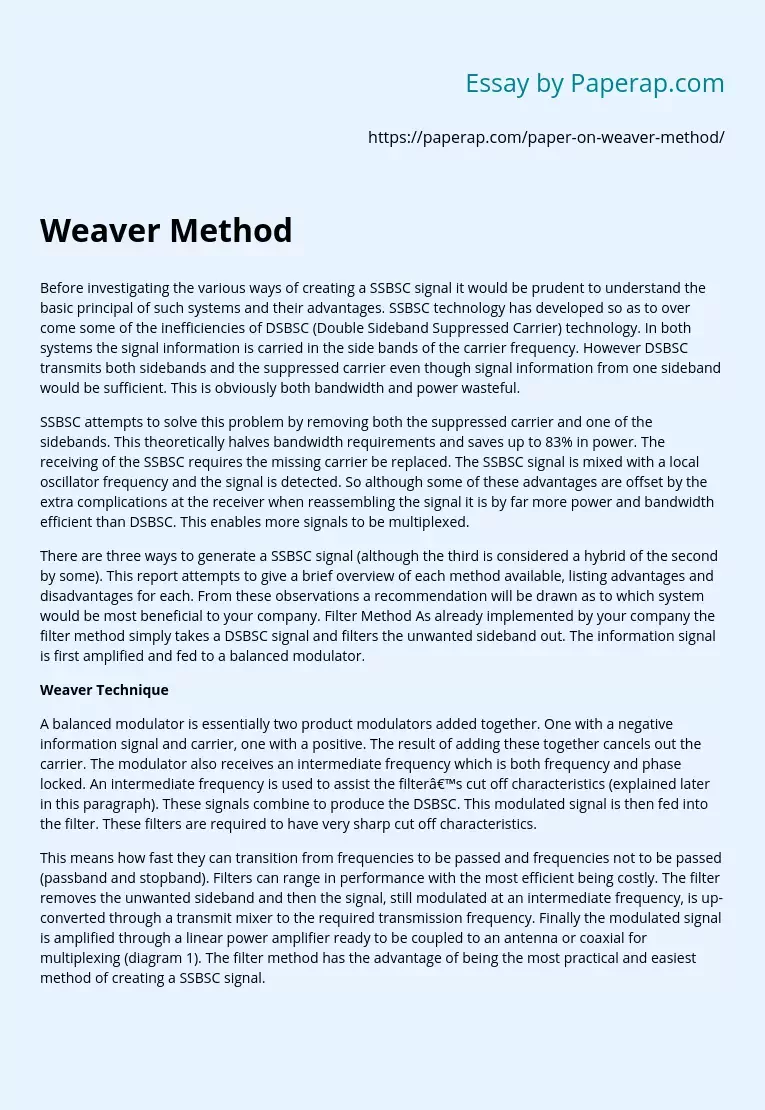Basic Principles and Benefits of Ssbsc
Before investigating the various ways of creating a SSBSC signal it would be prudent to understand the basic principal of such systems and their advantages. SSBSC technology has developed so as to over come some of the inefficiencies of DSBSC (Double Sideband Suppressed Carrier) technology. In both systems the signal information is carried in the side bands of the carrier frequency. However DSBSC transmits both sidebands and the suppressed carrier even though signal information from one sideband would be sufficient. This is obviously both bandwidth and power wasteful.
SSBSC attempts to solve this problem by removing both the suppressed carrier and one of the sidebands. This theoretically halves bandwidth requirements and saves up to 83% in power. The receiving of the SSBSC requires the missing carrier be replaced. The SSBSC signal is mixed with a local oscillator frequency and the signal is detected. So although some of these advantages are offset by the extra complications at the receiver when reassembling the signal it is by far more power and bandwidth efficient than DSBSC.
This enables more signals to be multiplexed.
There are three ways to generate a SSBSC signal (although the third is considered a hybrid of the second by some). This report attempts to give a brief overview of each method available, listing advantages and disadvantages for each. From these observations a recommendation will be drawn as to which system would be most beneficial to your company. Filter Method As already implemented by your company the filter method simply takes a DSBSC signal and filters the unwanted sideband out.
The information signal is first amplified and fed to a balanced modulator.
A balanced modulator is essentially two product modulators added together. One with a negative information signal and carrier, one with a positive. The result of adding these together cancels out the carrier. The modulator also receives an intermediate frequency which is both frequency and phase locked. An intermediate frequency is used to assist the filter’s cut off characteristics (explained later in this paragraph). These signals combine to produce the DSBSC. This modulated signal is then fed into the filter. These filters are required to have very sharp cut off characteristics.
This means how fast they can transition from frequencies to be passed and frequencies not to be passed (passband and stopband). Filters can range in performance with the most efficient being costly. The filter removes the unwanted sideband and then the signal, still modulated at an intermediate frequency, is up-converted through a transmit mixer to the required transmission frequency. Finally the modulated signal is amplified through a linear power amplifier ready to be coupled to an antenna or coaxial for multiplexing (diagram 1). The filter method has the advantage of being the most practical and easiest method of creating a SSBSC signal.
However building filters with a steep enough cut-off point at high frequencies is hard. Because of this filters have a tendency to include unwanted sideband frequencies and distort the wanted sideband. Filters that approach these high cut-off characteristics are also expensive. Standard frequency filters (for example 455 kHz, 10. 7 MHz) are a lot cheaper. Phasing Method The phasing method removes the necessity of a filter. The carrier and sideband are removed mathematically. The technique uses two DSBSC signals where the upper sideband or the lower sideband is out of phase by 90?
over the whole frequency range on one of the signals. As well as this one of the carrier signals is out of phase by 90? as well. This can be achieved through a Hilbert transformer. A signal out of phase by 90? is said to in-quadrature to its original signal and is therefore referred to as the quadrature signal (cosine). The other original signal is referred to as the in-phase signal (sin). There are now two signals :
- Signal 1 – Carrier in-phase, information signal LSB or USB in-quadrature
- Signal 2 – Carrier in-quadrature, information LSB and USB signal in-phase
A quality of in-quadrature and in-phase signals is that they cancel each other out when added and herein lies the principal of this method. Both signals are fed into their own balanced modulators their outputs are super-imposed on each other with the result being a cancellation of the carrier and the LSB. If the phase shift is reversed to -90? then the USB will be removed and the LSB will remain (Diagram 2). If spacing between in-phase and quadrature signals is not all to 90? or amplitude of in-phase and quadrature carrier is not equal then the unwanted sideband will not be completely cancelled.
Basic Principles and Benefits of Ssbsc. (2019, Dec 05). Retrieved from https://paperap.com/paper-on-weaver-method/

